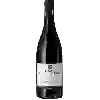
Winery Bertrand-BergéLa Bouliére Blanche
In the mouth this white wine is a powerful.
This wine generally goes well with vegetarian, poultry or lean fish.
Taste structure of the La Bouliére Blanche from the Winery Bertrand-Bergé
Light | Bold | |
Dry | Sweet | |
Soft | Acidic |
In the mouth the La Bouliére Blanche of Winery Bertrand-Bergé in the region of Pays d'Oc is a powerful.
Wine flavors and olphactive analysis
Food and wine pairings with La Bouliére Blanche
Pairings that work perfectly with La Bouliére Blanche
Original food and wine pairings with La Bouliére Blanche
The La Bouliére Blanche of Winery Bertrand-Bergé matches generally quite well with dishes of pasta, vegetarian or poultry such as recipes of pad thai, quiche with leeks and fresh salmon from flo or chicken and mushroom risotto.
Details and technical informations about Winery Bertrand-Bergé's La Bouliére Blanche.
Discover the grape variety: Okuzgozu
This grape variety is native to Turkey, where it is very well known and highly appreciated. In this country, it is very often grown at high altitudes, sometimes 1,000 metres or more. It is virtually unknown in France and in other wine-producing countries.
Informations about the Winery Bertrand-Bergé
The Winery Bertrand-Bergé is one of of the world's great estates. It offers 19 wines for sale in the of Vallee du Torgan to come and discover on site or to buy online.
The wine region of Vallee du Torgan
The wine region of Vallee du Torgan is located in the region of Pays d'Oc of Vin de Pays of France. Wineries and vineyards like the Domaine Bertrand-Bergé or the Domaine Mont Tauch produce mainly wines pink, red and white. The most planted grape varieties in the region of Vallee du Torgan are Merlot, they are then used in wines in blends or as a single variety. In the mouth of Vallee du Torgan is a powerful with a nice freshness.
The wine region of Pays d'Oc
Pays d'Oc is the PGI for red, white and rosé wines that are produced over a wide area of the southern coast of France. The PGI catchment area corresponds roughly to the Languedoc-roussillon">Languedoc-Roussillon wine region, one of the largest wine regions in France. The area covers all wines that are not produced under the strict laws that govern AOC-level appellations in the regions: among them, Corbières, Minervois and the Languedoc appellation itself. The Pays d'Oc PGI is arguably the most important in France, producing the majority of the country's PGI wines.
The word of the wine: Mineral
Taste reminiscent of gunflint, chalk and many nuances of the mineral world, and reinforcing, especially in white wines, the notion of freshness and the sappy character.




